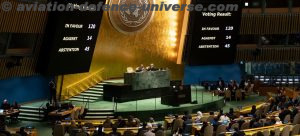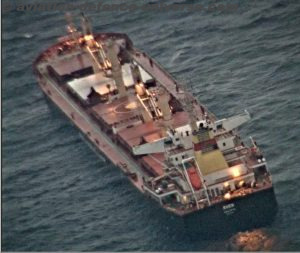Washington. 13 March 2019. Department of Defense Press Briefing on the President’s Fiscal Year 2020 Defense Budget for the Missile Defense Agency. Missile Defense Agency Deputy Director Rear Adm. Jon Hill; Missile Defense Agency Director of Operations Michelle Atkinson.
STAFF: Ladies and gentlemen, thank you for coming. Appreciate your attendance after a pretty long day, I know, this is going to be your last briefing of the day. Welcome, I’m Mark Wright, PAO for the Missile Defense Agency. Let me introduce you to your speakers for today.
On my — on your right is Ms. Michelle Atkinson. She is the director for operations, the acting director for operations for the Missile Defense Agency. And to her right is Rear Admiral Jon Hill, the deputy director of the Missile Defense Agency.
They’ll give an opening statement and then go through some slides for you and give you some additional information. I know you’ve already — should have picked up an MDA packet with information from OSD/PA. Make sure you get one if you haven’t yet.
Right after that, she’ll go through the budget slides for you and then we’ll have time for some questions. I ask that when time for questions, the admiral doesn’t know you, neither does Ms. Atkinson, so please identify yourself and where you’re from and then we’ll answer your question as best as possible.
We should have about 20 minutes for each if everything works out all right. Admiral?
REAR ADMIRAL JOHN REAR ADM. HILL: Okay, thank you Mark, and good afternoon. As Mark mentioned, we are well aware that this is your last brief of the day and so we’ll try to keep you excited here. It’s great to have an opportunity to talk to you about the importance of the president’s budget request.
And as you know, MDA has an incredibly important mission. We develop and deploy missile defenses to protect the homeland as well as to protect our deployed forces and allies all over the world from the threat of missile attack.
I’m incredibly proud of that mission. It is a noble mission and I’m incredibly proud of the men and women of MDA that make us — make this possible. So at this point, without any further ado, I’d like to turn it over to Ms. Michelle Atkinson, who is our director for operations. So she can run you through the particulars of our budget request for FY20.
And then we’ll be happy to take your questions.
MICHELLE ATKINSON: Thank you, Admiral. Good afternoon. I appreciate the opportunity to brief you today on the Missile Defense Agency fiscal year ’20 budget request.
Our budget request is consistent with the president’s commitment to expand and improve our missile defense capability, while at the same time recognizing that we must be able to address tomorrow’s threats, which continue to expand and advance. Next chart.
In FY 20, MDA will continue to strengthen and expand the deployment of defenses for our nation, deployed forces, allies, and international partners against increasingly capable missile threats. The missile defense program will support our war fighters and the needs of the combatant commanders by developing, integrating, testing, and deploying interceptors, sensors, and improvements to the ballistic missile defense system. Next chart.
MDA’s priorities for missile defense are nested within the national defense strategy priorities and are as follows: First, we must continue to focus on increasing system reliability to build warfighter confidence. We need to increase engagement capability and capacity and also rapidly address the advancing missile threats.
Our budget request maintains operational missile-defense capabilities for existing homeland and regional defense forces, continues to increase interceptor inventory, and will use existing technologies to improve sensors, battle management, fire control, and kill vehicle capabilities to address the evolving threats. Next chart.
The current BMDS can defeat the current ballistic missile capabilities of our adversaries but we require additional capacity and advanced capabilities in order to stay ahead of the evolving threat.
The projected missile threat is complex and volatile, and it includes evolving ballistic and hypersonic missile threats. It is critical that we continue to develop innovative and breakthrough technologies to outpace rogue state offensive missile capabilities against the U.S. homeland.
This evolving threat demands a globally present and persistent sensor network to be able to track it from birth to death.
The recently completed Missile Defense Review recognizes the evolving missile threats that we face and underscores that missile defense must remain a high-priority investment in our National Defense Strategy.
Indeed, the missile defense mission is expanding to include non-ballistic threats. Aligned with the current National Defense Strategy, the MDR strengthens our posture as we continue to make progress in the development and fielding of a BMDS to defend our homeland, our deployed forces, our allies and partners.
The MDR supports the critical need to pursue new concepts and technologies to address tomorrow’s threat. The MDR also emphasizes our continued pursuit of cooperative relationships with allies and partners, to field interoperable and effective regional missile defenses.
Next chart.
MDA’s FY ’20 budget request is a total of $9.4 billion to continue the development of a reliable, increasingly capable and state-of-the-art missile defense for our nation, deployed forces, allies and international partners.
Our priority in this budget remains the delivery of greater missile defense capability and capacity to our warfighters, and includes investments in advanced technology development and future capabilities.
Next chart.
MDA remains committed to delivering, expanding and sustaining our nation’s homeland missile defenses, and we request $1.8 billion in FY ’20 for the Ground-based Midcourse Defense, or GMD, program.
In FY ’20, we will continue to have 40 ground-based interceptors deployed at Fort Greely, Alaska, and four at Vandenberg Air Force Base in California.
We will strengthen and expand homeland missile defenses by continuing the construction of a new missile field at Fort Greely, and work to deploy 20 additional interceptors at Fort Greely, which will increase the total deployed GBIs from 44 to 64.
This budget also continues development of the Redesigned Kill Vehicle, or RKV. We are committed to using a rigorous engineering and test approach that provides a system to the warfighter that is both reliable and effective.
A two-year delay to the RKV program was necessary in order to complete design modifications and perform the testing to demonstrate that the RKV system will meet its requirements. Also in FY ’20, we will conduct a GMD flight test using a GBI launched from Vandenberg.
For the Long Range Discrimination Radar — or LRDR — we are requesting $136 million in FY ’20. This radar, which will be available in 2020, is a critical midcourse sensor that will improve BMDS target discrimination capability and support a more efficient use of our GBIs.
We are requesting $128 million for the Sea-Based X-Band Radar, which provides precision midcourse tracking and discrimination to protect the homeland.
As of now, SBX has been at sea for more than 500 days without a port visit. The FY ’20 program continues to provide extended SBX sea time to maintain its important contribution to homeland defense.
Our budget also requests $20 million for the Cobra Dane radar, to continue radar refurbishment and life extension in partnership with the U.S. Air Force.
Our P.B. ’20 request also includes funding for two additional radars, which will help provide persistent discrimination, precision tracking and hit assessment to support defense of the homeland against long-range missile threats.
We are requesting $275 million to continue the Homeland Defense Radar-Hawaii, which is scheduled to be available in 2023. We are also requesting $7 million for the Pacific Discriminating Radar, to be available in the 2026 timeframe at a location to be determined.
Next chart.
Moving now to regional defenses. Our FY ’20 request for Aegis BMD is $1.7 billion, which includes sustaining deployed Standard Missile 3 fleet, and upgrading Aegis ships to add BMDS capability.
We will procure 30 Aegis SM-3 Block IB missiles for deployment on land, at the Aegis Ashore sites in Romania and Poland, and at sea on multi-mission Aegis BMD ships. This will bring the total number of SM-3 Block IB missiles procured to 361 by the end of F.Y. ’20. In FY ’20, we will also continue the multi-year procurement for the SM-3 Block IB missile.
We will procure seven SM-3 Block IIA missiles, for a total of 54 missiles procured through F.Y. ’20. In FY ’20, we will also continue SM-3 Block IB modernization, and the SM-3 Block IIA software upgrade programs.
We will also continue work with the U.S. Navy to integrate the SPY-6 Aegis Missile Defense Radar with the Aegis weapons systems.
Our FY ’20 request for the Terminal High Altitude Area Defense — or THAAD — program is $854 million. This will allow us to support the maintenance, sustainment of all BMDS-unique items for the seven fielded THAAD batteries and all of the THAAD training devices.
This budget also procures 37 THAAD interceptors in support of the U.S. Army, bringing the total to 568 by the end of FY ’20.
Additionally in FY ’20, we will continue THAAD’s software development and upgrades, and integration of missile defense capabilities on the Korean Peninsula.
We are requesting $543 million to support and sustain 12 TPY-2 radars, which includes the forward-based mode radars in Japan, Turkey, Israel and U.S. Central Command.
This funding also continues software development to improve discrimination capabilities, and other upgrades to improve the TPY-2 radar performance.
Our budget request of $500 million in FY ’20 for Israeli programs continues MDA’s longstanding support of U.S.-Israeli cooperative programs to include Iron Dome, David’s Sling and the Arrow weapons systems.
Finally, in support of phase three of the European Phased Adaptive Approach, or EPAA, our P.B. ’20 budget request includes $64 million to complete the Aegis Ashore site in Poland to be available in 2020, and also to make capability improvements at other Aegis Ashore sites.
Next chart.
MDA is developing advanced missile defense technologies for integration into the BMDS to defeat the rapidly evolving threats. The investment strategy for these technologies balances the need to address the most dangerous current threats with the need to position the U.S. to respond to threat developments in the future.
We are requesting $157 million for hypersonic defense. The FY ’20 plan includes software modifications to current BMDS assets, and further defines the architecture for future capability demonstrations.
Our request for technology maturation initiatives is $304 million. This includes the new effort for the development of a neutral particle beam that will leverage past and current work on particle beams, related enabling technology, laser pointing and laser stability to provide a component technology for a future system that will offer new kill options for the BMDS and will add another layer of protection for the homeland.
This funding also provides laser scaling efforts to scale up power levels to support DOD-wide capability objectives.
Our FY ’20 budget request also continues discrimination sensor technology development and supports advanced technology testing. We are requesting $63 million for MDA space efforts in FY ’20 to sustain the two Space Tracking and Surveillance System satellites operating in low earth orbit and to continue development of the space based kill assessment sensor network.
We are requesting $14 million for the Multi-Object Kill Vehicle, or MOKV, to fund technology risk reduction efforts to establish a foundation for killing multiple lethal objects with a single interceptor. Next chart.
We are requesting $564 million in FY ’20 for the Command and Control Battle Management Communications system, or C2BMC. We will continue to support current C2BMC capability in CENTCOM, EUCOM, INDOPACOM and NORTHCOM, with upgrades that integrate the Aegis engage-on-remote and LRDR capability.
We are requesting $554 million in FY ’20 to develop threat representative targets and $396 million to conduct BMDS flight and ground testing. Critical flight tests in FY ’20 include FTM-44, which is an Aegis BMD test against a long range target, and FTO-03, which is an integrated THAAD, Aegis and Patriot operational test against multiple targets. Next chart.
In summary, the MDA F.Y. ’20 budget request continues to focus on sustaining and increasing system reliability for BMDS elements such as THAAD, GMD, Aegis, TPY-2 and Cobra Dane. It also focuses on increasing engagement capability with efforts such as the new LRDR radar in Alaska, and it also addresses the advanced threats with efforts such as the hypersonic defense program.
In FY ’20, MDA will continue to make progress in the development and deployment of a reliable layered Ballistic Missile Defense System to defend our homeland, our deployed forces, our allies and partners from missile attacks of all ranges and in all phases of flight.

























































































































